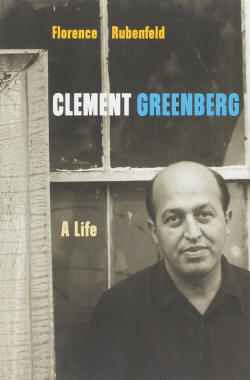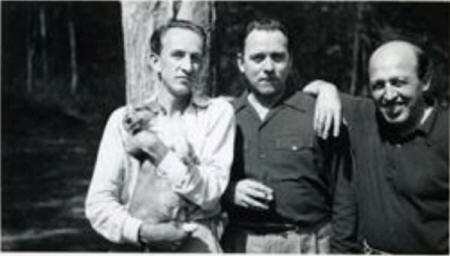

Partner Jean Connolly
Queer Places:
6 Jones St, New York, NY 10014
50 Greenwich Ave, New York, NY 10011
248 W 11th St, New York, NY 10014
90 Bank St, New York, NY 10014
 Clement Greenberg (January 16, 1909 – May 7, 1994),[1] occasionally writing under the pseudonym K. Hardesh, was an American essayist known mainly as a very influential visual art critic closely associated with American Modern art of the mid-20th century and a Formalist aesthetician. He is best remembered for his association with the art movement Abstract Expressionism and the painter Jackson Pollock.
Clement Greenberg (January 16, 1909 – May 7, 1994),[1] occasionally writing under the pseudonym K. Hardesh, was an American essayist known mainly as a very influential visual art critic closely associated with American Modern art of the mid-20th century and a Formalist aesthetician. He is best remembered for his association with the art movement Abstract Expressionism and the painter Jackson Pollock.
Clement Greenberg was born in the borough of the Bronx, NYC, in 1909. His parents were middle-class Jewish immigrants, and he was the eldest of their three sons. Since childhood, Greenberg sketched compulsively, until becoming a young adult, when he began to focus on literature. Greenberg attended Erasmus Hall High School, the Marquand School for Boys, then Syracuse University, graduating with an A.B. in 1930, cum laude, Phi Beta Kappa.[2] After college, already as fluent in Yiddish and English since childhood, Greenberg taught himself Italian and German in addition to French and Latin. During the next few years, Greenberg travelled the U.S. working for his father's dry-goods business, but the work did not suit his inclinations, so he turned to working as a translator. Greenberg married in 1934, had a son the next year, and was divorced the year after that. In 1936, Greenberg took a series of jobs with the federal government, from Civil Service Administration, to the Veterans' Administration, and finally to the Appraisers' Division of the Customs Service in 1937. It was then that Greenberg began to write seriously, and soon after began getting published in a handful of small magazines and literary journals.[3]
Though his first published essays dealt mainly with literature and theatre, art still held a powerful attraction for Greenberg, so in 1939, he made a sudden name as a visual art writer with possibly his most well-known and oft-quoted essay, "Avant-Garde and Kitsch", first published in the journal Partisan Review.
Early in 1942, Rupert Barneby and Dwight Ripley went to New York, joining their friend Jean Connolly, who had moved east and could introduce them immediately to the art world that Rupert like to call "Upper Bohemia." Jean's current lover, only somewhat to the chagrin of her likewise active husband, Cyril Connolly, back in Englad, was Clement Greenberg. Greenberg, writing to his friend Harold Lazarus described the new arrivals: "Dwight Ripley, a millionaire and rather masculine... and his pal, Rupert Barneby. They are both botanist and English," reported Greenberg, "and Dwight is in addition a philologist, expert in the Latin languages and Russian. Something new."

Rupert Barneby (holding Possum), Dwight
Ripley, and Clement Greenberg at Dwight and
Rupert's home at Wappingers Falls, 1951.
Cyril Connolly blamed his marital difficulties on Jean Connolly's friends in Pansyhalla. "WE have still done nothing," he complained, "we have talked, quarrelled, drunk and laughed a great deal, and made love, but constructed nothing and not even really helped out friends, our only creations, Tony Bower and Nigel Richards." Bower believed, as did Dwight Ripley, that the separation (they called it "the parturition") had more to do with Cyril Connolly's being the child to Jean. When she returned to England because of the war, it appeared the marriage might be salvaged after all. Dwight had offered the Spinney, but Jean thought better of it. "The Connollys haven't showed up," he reported to Rupert Barneby. Instead she went biking near Trewyn with Peter Watson's lover, Denham Fouts, proceeded with him to Ireland, and from there the two departed for New York. Fouts was to be entrusted in America with Watson's five-by-four-foot Picasso, Girl Reading at a Table, which had been on view in the Picasso retrospective at the Musuem of Modern Art. Fouts continued south to visit his family in Florida, where Jean panned to join him for a drive cross-country to California. She first had an errand to accomplish on behalf of Cyril, who had asked her to contact a prospective contributor to Horizon and encouraged him to submit material. This was Clement Greenberg, an employee then of the US Custom Service, whose now famous essay, "Avant-Garde and Kitsch" had impressed Connolly when it appeared the previous year in Partisan Review. Jean didn't telephone; she simply knocked at Greenberg's door. In his letters to Harold Lazarus, Greenberg described the resulting affair. Fouts, losing patience, started for California by himself. Jean caught up with him in Dallas, and in Los Angeles they joined their refugee friends, who included, by this time, Tony Bower. The interlude that followed was to inspire the "Paul" chapter in Down There on a Visit by Christopher Isherwood (1962). Jean became "Ruthie," Fouts is "Paul," Bower is "Ronnie," and Gerald Heard is "Augustus Parr."
Greenberg wrote several seminal essays that defined his views on art history in the 20th century. In 1940, Greenberg joined Partisan Review as an editor. He became art critic for the Nation in 1942. He was associate editor of Commentary from 1945 until 1957.[5]
Just after the war Clement Greenberg lived at 248 West 11th Street, New York. Earlier he lived at 50 Greenwich Avenue, later 90 Bank Street, all in the same section of the Village not far from Dwight Ripley's own first address. It was Jean Connolly, in the autumn of 1941, who found the Greenwich Avenue apartment, furnished it, cooked there, and sometimes paid the rent. Greenberg was once widely attached for his influence as an art critic, especially as exercised in the period after 1960 when he moved uptown and became identified with the abstract style known as Color Field painting. Greenberg too, like Jean Connolly's previous husband, Cyril Connolly, found Jean's make friends to be an inconvenience. "I want to Blitzrieg the cities of the plain," he confided to Lazarus. Apparently he made an exception for Rupert Barneby and Dwight Ripley. The four of them, Dwight was the oldest at 33, Clem 32, Jean 31, and Rupert 30, met for the first time on the Saturday evening of January 31, 1942, for dinner at Voisin, a restaurant that had various addresses in the East 60s near Park Avenue, and where, thought Dwight, "the food and décor are the best in town." At the end of WWII Greenberg was assigned to a squadron that was soon to be sent overseas to repair recently captured enemy airfields. But he was soon discharged on the recommendation of the camp psychiatrist. When he returned to New York that September he discovered that Jean was involved already with Peggy Guggenheim's ex-husband, Laurence Vail.
In December 1950, Greenberg joined the government funded American Committee for Cultural Freedom. Greenberg believed Modernism provided a critical commentary on experience. It was constantly changing to adapt to kitsch pseudo-culture, which was itself always developing. In the years after World War II, Greenberg pushed the position that the best avant-garde artists were emerging in America rather than Europe.[6] Particularly, he championed Jackson Pollock as the greatest painter of his generation, commemorating the artist's "all-over" gestural canvases. In the 1955 essay "American-Type Painting" Greenberg promoted the work of Abstract Expressionists, among them Jackson Pollock, Willem de Kooning, Hans Hofmann, Barnett Newman, and Clyfford Still, as the next stage in Modernist art, arguing that these painters were moving towards greater emphasis on the 'flatness' of the picture plane.
He praised similar Modernist art movements abroad and, after the success of the Painters Eleven exhibition in 1956 with the American Abstract Artists at New York's Riverside Gallery, he travelled to Toronto to see the group's work in 1957. He was particularly impressed by the potential of painters William Ronald and Jack Bush, and later developed a close friendship with Bush.
Greenberg was married in May 1956 to Janice Van Horne, and Dwight Ripley marked the occasion by presenting him a watch from Cartier. The critic was offended, on the defensible grounds that a wedding present should be given to Clem and Jenny both. He wore the watch, even so, for the rest of his life. You can see it in the later photographs. Van Horne remembered arriving with Greenberg at a party given by Dwight at 416 East 58th Street. Dwight, who had pushed his way across the room calling "Clem! Clem!", proceeded to kiss her husband, not glancingly, on the mouth. Greenberg, accepting the challenge, kissed Dwight as forcefully back.
Through the 1960s Greenberg remained an influential figure on a younger generation of critics including Michael Fried and Rosalind E. Krauss. Greenberg's antagonism to 'Postmodernist' theories and socially engaged movements in art caused him to become a target for critics who labelled him, and the art he admired, as "old fashioned". In his book "The Painted Word", Tom Wolfe criticized Greenberg along with Harold Rosenberg and Leo Steinberg, whom he dubbed the kings of "Cultureburg".[8]
In 2000, the Portland Art Museum (PAM) acquired the Clement Greenberg Collection of 159 paintings, prints, drawings, and sculpture by 59 important artists of the late-20th century and early-21st century. PAM exhibits the works primarily in the Jubitz Center for Modern and Contemporary Art – some sculpture resides outdoors. Most of the artists represented are American, along with several Canadians, and a handful of artists of other nationalities. Artists represented in the collection include among others: Edward Avedisian, Walter Darby Bannard, Stanley Boxer, Jack Bush, Anthony Caro, Dan Christensen, Ronald Davis, Richard Diebenkorn, Enrico Donati, Friedel Dzubas, André Fauteux, Paul Feeley, Helen Frankenthaler, Robert Goodnough, Adolph Gottlieb, Hans Hofmann, Wolfgang Hollegha, Robert Jacobsen, Paul Jenkins, Seymour Lipton, Georges Mathieu, Kenneth Noland, Jules Olitski, William Perehudoff, Jackson Pollock, Larry Poons, William Ronald, Anne Ryan, David Smith, Theodoros Stamos, Anne Truitt, Alfred Wallis, and Larry Zox.[9] Greenberg's widow, Janice van Horne, donated his annotated library of exhibition catalogues and publications on artists in Greenberg's collection to the Portland Art Museum.[10] Greenberg's annotated library is available at the Portland Art Museum's Crumpacker Family Library which is open to the public free of charge.
Greenberg was portrayed by actor Jeffrey Tambor in the 2000 film Pollock, about the life of Jackson Pollock.
My published books: